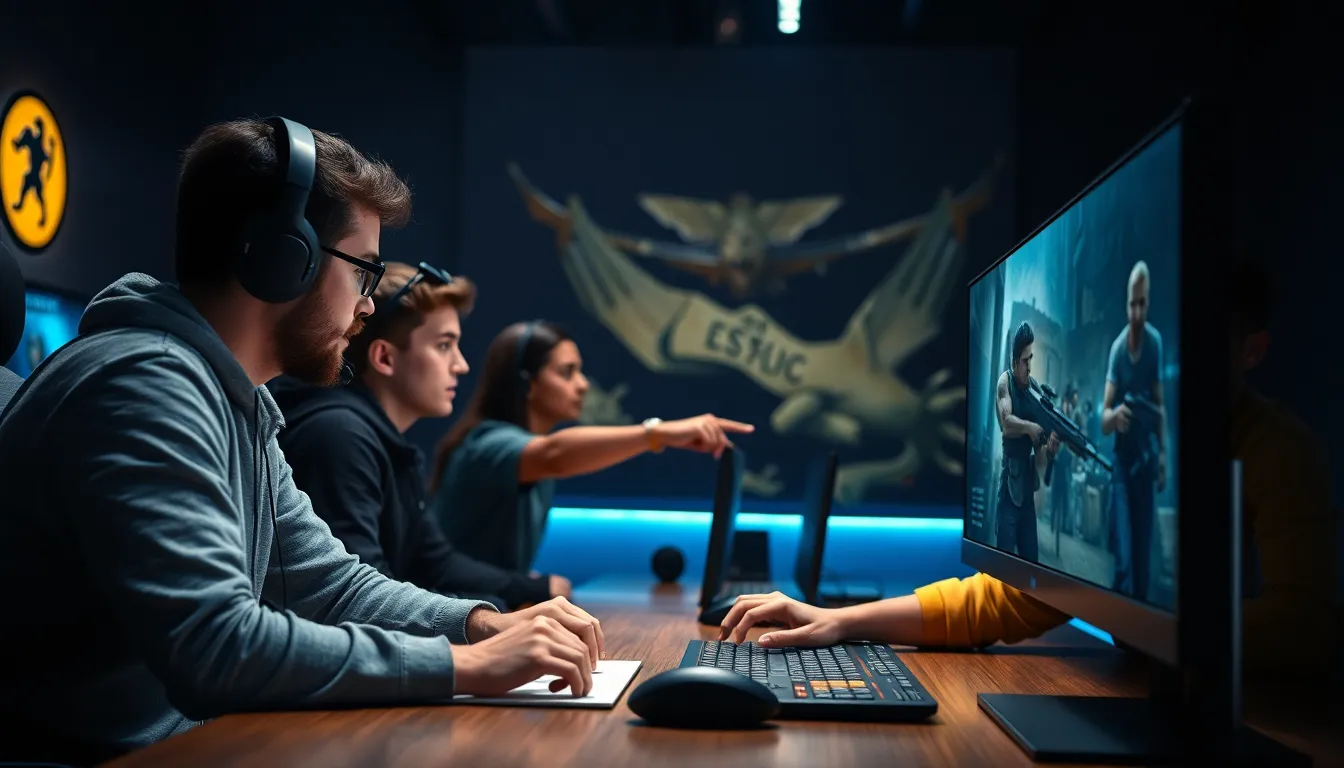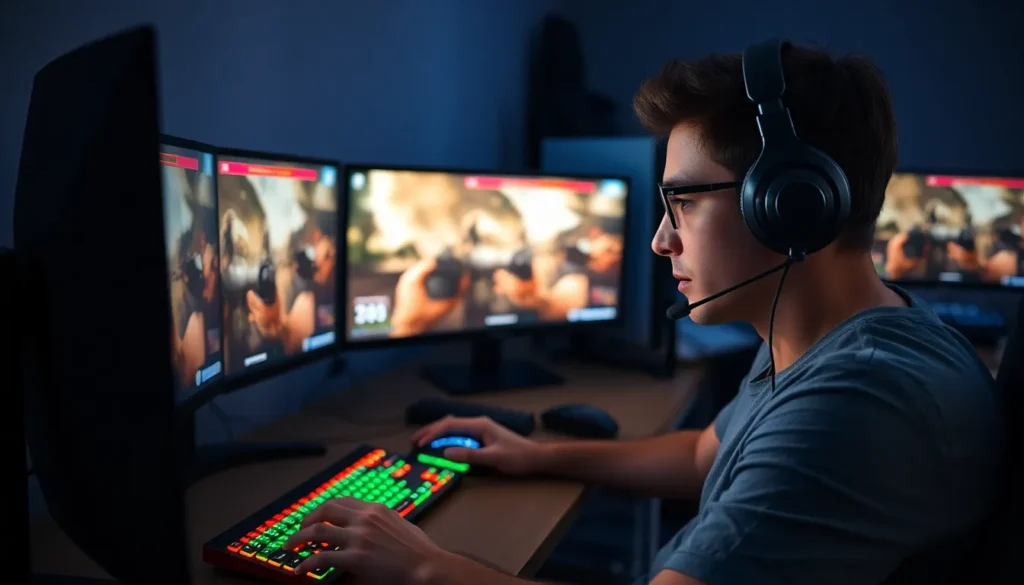Table of Contents
ToggleIn the fast-paced world of first-person shooters, teamwork isn’t just a nice-to-have; it’s the secret sauce that transforms a ragtag group of players into a well-oiled killing machine. Imagine trying to win a game of chess with a bunch of pawns running in every direction—chaos, right? That’s what happens when FPS teams lack solid strategies.
Overview of FPS Team Strategies
In FPS games, strategies dictate success. Key components involve communication, positioning, and coordination. Effective communication ensures all team members understand objectives and respond swiftly during critical moments. Establishing clear roles helps optimize player strengths, such as designating snipers for long-range engagements and heavies for frontline operations.
Positioning greatly influences outcomes in battle. Players should occupy advantageous spots, ensuring line of sight and cover. Using terrain as a tactical advantage can neutralize enemy fire and create opportunities for ambushes. Coordination amplifies these strategies. Teams benefit from synchronized movements, allowing them to flank opponents and control critical areas.
Utilizing strategies like baiting can also be effective. One player can draw out enemies, allowing teammates to execute a surprise attack. Additionally, strategic retreats may provide crucial time for regrouping and healing. Resource management plays a role as well. Teams that prioritize ammunition and health packs often maintain momentum longer.
Choosing the right game modes helps refine specific strategies. Objective-based modes encourage teamwork for capturing or defending key points. Deathmatch modes typically emphasize individual skill but no less rely on teammate support.
Implementing these strategies fosters a culture of teamwork and enhances overall performance. Observation of enemy patterns can inform adaptations during gameplay, enabling teams to respond to evolving circumstances dynamically. Overall, a solid grasp of these strategies allows teams to outmaneuver opponents, securing victory through effective tactical execution.
Key Elements of Effective Team Play

Effective teamwork rests on communication and role assignment. Players must understand objectives while leveraging their individual strengths.
Communication Techniques
Clear communication fosters understanding and responsiveness. Using in-game voice chat or messaging apps helps convey strategies and reactions quickly. Players can call out enemy positions and alert teammates about resource availability. Establishing keywords for specific maneuvers streamlines action during engagements. Incorporating regular check-ins ensures everyone remains focused and aligned. Listening actively to teammates allows for real-time adjustments. Maintaining a calm tone helps reduce panic, promoting a level-headed approach essential in high-stakes moments.
Role Assignment
Assigning roles optimizes a team’s collective strengths. Designating roles such as sniper, medic, or heavy establishes clear responsibilities. Each player performs their part, whether providing support, dealing damage, or healing teammates. This structure enhances overall efficiency during matches. Adaptability is crucial, as teams must adjust roles based on opponents and gameplay dynamics. A strong front-line player should absorb damage and protect teammates, while agile players can flank enemies and secure key positions. By clarifying roles, teams operate cohesively, increasing their chances of success in battle.
Popular FPS Team Strategies
Team strategies play a vital role in enhancing performance in FPS games. Several effective tactics can elevate team dynamics, ensuring successful engagements.
Flanking Maneuvers
Flanking maneuvers catch opponents off guard, creating openings for surprise attacks. By splitting the team, players can approach enemies from different angles, distracting them. One part may engage head-on while another moves around the side, achieving higher lethality. Communication remains crucial here, as players must coordinate their movements to capitalize on opportunities. Timing matters; executing the flank simultaneously leads to more effective results. Teams employing this strategy often secure key objectives effectively, keeping opponents on the back foot.
Crossfire Formation
Crossfire formation maximizes damage output and control over a battlefield. Players establish positions on opposite sides of a target, ensuring both attackers and defenders are under constant threat. This strategy relies heavily on establishing clear lines of sight. Communication among team members supports an effective setup, as they relay enemy locations and movements. Coordination enhances fluidity, allowing teams to adapt to changing situations. Utilizing this formation provides an overwhelming advantage, often leading to quick eliminations and securing critical points on the map.
Analyzing Successful Teams
Successful FPS teams demonstrate effective cooperation through clearly defined strategies, showcasing how teamwork directly impacts performance. This section analyzes two case studies that exemplify effective team dynamics.
Case Study: Team A
Team A excelled in communication and strategy execution. Integrating voice chat into gameplay allowed members to discuss real-time tactics, enhancing their responses during critical moments. Defined roles within the team promoted efficiency. For example, the designated sniper provided long-range support, while medics focused on healing teammates, ensuring sustained combat effectiveness. Regularly analyzing past matches helped them refine their decision-making processes. They adapted quickly, employing flanking strategies that caught opponents off guard. This flexibility, combined with established cues for maneuvers, facilitated successful engagements and objective captures.
Case Study: Team B
Team B’s strength lay in their positioning and coordination skills. By maintaining advantageous spots on the map, they maximized line of sight while providing effective cover for teammates. Collaboration was key; players focused on synchronizing their movements, allowing them to create crossfire opportunities. Strategic retreats played a significant role in their success, giving the team a chance to regroup and reassess during intense battles. They emphasized resource management, ensuring they conserved ammunition and utilized health packs efficiently. This meticulous planning fostered a cohesive team environment, resulting in impressive gameplay and victory in various matches.
Challenges in Implementing Strategies
Implementing strategies in FPS games encounters various challenges that can impact overall team effectiveness.
Team Coordination
Coordination challenges arise when team members fail to maintain synchronized movements. Effective communication becomes essential, as players need to share real-time updates about enemy positions and tactics. Clarity in role assignments also plays a critical role; without defined responsibilities, chaos can ensue during engagements. Additionally, reliance on in-game tools, like voice chat or ping systems, can facilitate smoother interactions but may still lead to miscommunications. Timely adjustments to strategies are crucial when dealing with dynamic game situations. Frequent rehearsals of coordinated maneuvers can enhance team cohesion, inviting a stronger collaborative approach in matches.
Adapting to Opponents
Adapting to opponents presents its own set of challenges in implementing strategies. Teams must analyze enemy behavior to identify patterns and weaknesses. Observing their movements fosters better predictive capabilities, leading to more effective flank and counteroffensive maneuvers. Flexibility remains essential; strategies that work against one team may fail against another. Therefore, continuous assessment of opponent tactics allows for timely adaptations. A collective understanding of enemy playstyles prepares teams for rapid changes during gameplay. Maintaining a proactive attitude can help players counteract unpredictable moves, ensuring a competitive edge throughout the match.
Mastering FPS team strategies can significantly elevate gameplay and foster a winning environment. By prioritizing communication and clearly defined roles teams can navigate the chaos of battle with precision. Effective positioning and coordination not only enhance individual performance but also create opportunities for collective success.
Utilizing tactics like flanking and crossfire can turn the tide in critical moments. Continuous assessment of both team dynamics and opponent strategies ensures adaptability in ever-changing scenarios. As teams refine their approach and embrace these strategies they’ll find themselves better equipped to tackle challenges and secure victories.







